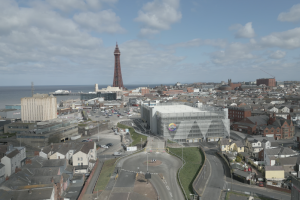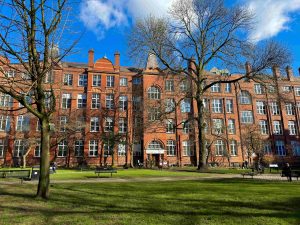Tall buildings key to Liverpool Waters, says Ashworth

PEEL has said the tall buildings featured in its £5.5bn Liverpool Waters masterplan are an essential part of the scheme, even though they have proved to be the ultimate stumbling block between the company and English Heritage.
Speaking ahead of a Liverpool City Council planning meeting next Tuesday, Peel Developments director Lindsey Ashworth said that developing tall buildings “is not something that we do” at Peel in general.
“But you can see that for the Wirral and Liverpool developments it’s the right thing to do. It’s got to be something that’s visually dynamic.”
Mr Ashworth argued that although the earliest artists’ impressions had scores of skyscrapers on the site, the new masterplan shows that “it’s not a site 
In fact, there are around 12 towers in the plans, concentrated around two clusters. The tallest of these will contain 50-60 storeys and be almost 150m high. In total, some 18.2m sq ft of buildings are proposed for the 60-hectare site – the bulk of which is being reclaimed from the Mersey river.
“What we don’t want is a development that looks the same all the way through it,” he said.
He also argued that Peel had addressed most of English Heritage’s concerns, including completing huge surveys of archaeological remains of former docks and re-siting buildings within the masterplan to ensure that they avoided archaeological remains. 
Mr Ashworth said that Peel had been working “night and day” with the council’s planning officers to gain a recommendation to approve the scheme from planning officers, subject to a stringent series of conditions.
Peel has also dismissed notions that there may not be enough demand from tenants for the 18m sq ft of buildings it is proposing to build, including 9,000 residential units, up to 3.4m sq ft of offices, 654 hotel rooms, 200,000 sq ft of retail, 80,000 sq ft of foodstore, 300,000 sq ft of restaurants and 200,000 sq ft of bars.
“This point in time doesn’t stand still,” said Ashworth. “I’ve been through a few recessions, and you can’t always assume or be so negative to think that we’ll always be on our bloody knees. It’s rubbish.
“As it happens, we were in a boom when I started this, it all collapsed, and to fund this through the recession has been very difficult.
“The faith that I’ve got in the Liverpool people, the council, and the Government for supporting us is such that I’ve carried on. We didn’t carry on with other projects. But I’ve spent enough now.”
English Heritage’s regional planning director, Henry Owen-John, refuted Peel’s charge that it had not contributed to the process. He argued that the organisation had previously been able to work constructively in the city with Grosvenor on Liverpool One, with Neptune Developments on the Mann Island site and with the new Museum of Liverpool at Pier Head.
“In all of those cases, we felt there was a healthy level of dialogue and we were given a good hearing. In some cases, the developer was able to say publicly that the scheme they ended up was better as a result of our involvement.”
He said that Peel had a firm idea of what it wanted from the outset and was “resistant to any ideas” to change the project. He added that objections which remain – including a lack of definition among some of the taller buildings proposed – were first raised in its initial submission to city planners back in September 2010.
UNESCO’s submission to the planning committee expresses “extreme concern” over the proposals, arguing that Peel’s scheme would impact on the authenticity of the World Heritage Status of Liverpool’s waterfront.
“It said there was an ‘absence of function’ between the buildings in Peel’s proposed masterplan and the historic buildings.
In a report prepared for the city’s planning committee, Liverpool City Council’s head of planning acknowledged that if the development goes ahead the city will probably be placed on a list of “World Heritage Sites in Danger”, but has argued that UNESCO’s report was “flawed”.
He claimed it “contains many fundamental inaccuracies” which stemmed from the fact that UNESCO’s recent delegation didn’t have a great deal of time to get to grips with the complexity of the site or the proposals.








